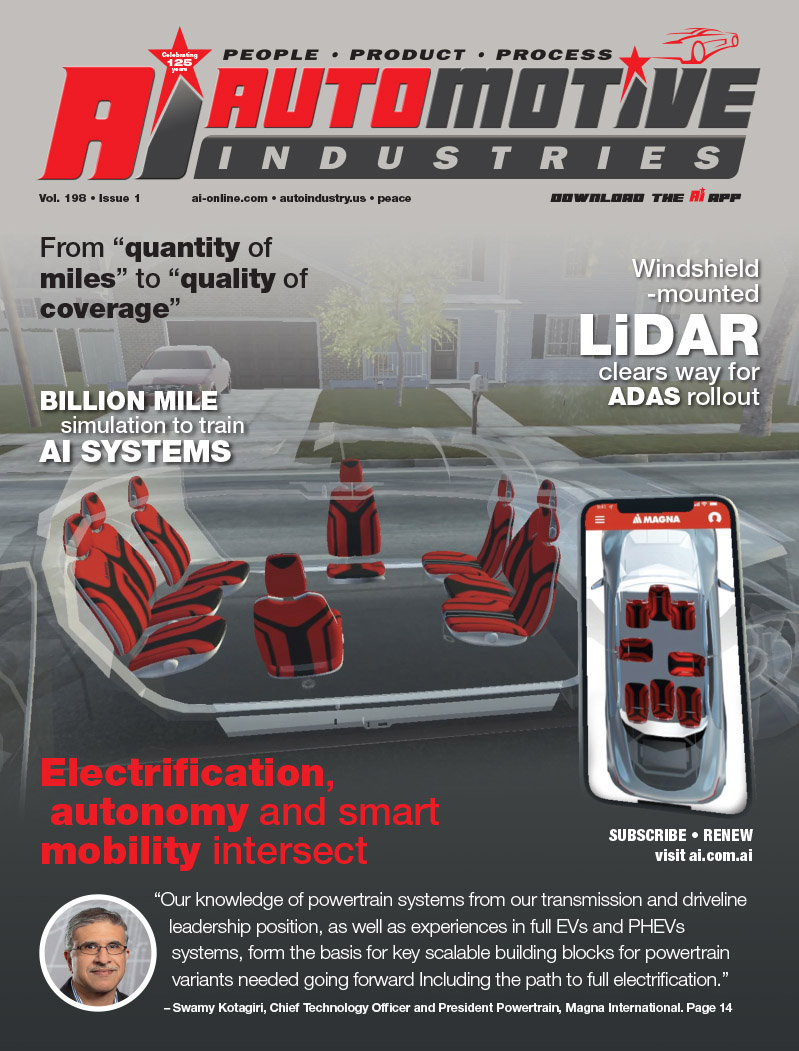
With the advent of new mobility and autonomous driving seat positioning will play an increasingly important role in creating a flexible space which can accommodate cargo or allow vehicle occupants to get work done and interact with each other more freely. One of the leaders in the field is Magna Seating, which used rich digital and in-market consumer research in China, Europe and the United States to understand what consumers want from vehicle seats.
“Magna’s seating innovation is driven by the belief that while the vehicle occupant experience will be very different with the introduction of mobility and autonomy, the functional basics will remain the same: passengers want convenience, flexibility and comfort,” said Mike Bisson, President Magna Seating at the release of the findings.
Automotive Industries (AI) asked Dino Nardicchio, Global Vice President Advanced Technology Engineering at Magna Seating, how the company is reducing the weight of seats. Nardicchio: We have a lot of experience bringing exotic and semi-exotic materials such as magnesium and aluminum to market for high-performance vehicles. There is a lot of value in our ability to use advanced and high-strength steels in order to provide very cost and mass effective seating structures for the mass market. Our competences in producing scalable and modular mechanisms helps us provide OEM customers with very efficient seat structures.
AI: How can Magna’s smart mobility seating concept make vehicles more adaptable to varying needs? Nardicchio: We are the pioneers of reconfigurable seating. In 2004 we brought Stow ‘n Go to market in North America. Stow ‘n Go is a seat that could literally fold and stow in the floor. It completely disrupted the entire minivan market in the US. In fact, GM and Ford no longer even produce minivans. In 2008 we brought to market Swivel ‘n Go. Swivel ‘n Go was a seat that faced forward and could swivel 180 degrees and face or rearward Swivel ‘n Go also had an integrated booster seat and the entire seat assembly was removable from the vehicle. From our research we’ve learned seats don’t meet the needs of drivers and passengers because their needs change throughout the day. So, our next generation of reconfigurable seating will enable much better user experiences. In a cargo mode scenario, a car sharing example, you could allow a courier company to use your commuter car to make deliveries while you are at work. Using an app they can reconfigure your interior to allow for maximum cargo space, with the passenger seat nested under the IP, the second and third row seats going into what we call stadium position while being moved forward on a long rail to provide space for packages that are large and small. Once the deliveries are done, they drop the vehicle back at your workplace and reconfigure the car at the press of a button to the original seating position. This example is using a very standard eight passenger seating configuration. The next mode is what we call the “Long Road Trip”. Everybody is very familiar with taking the family on the road. In this scenario the kids will probably want to take a potty break, and grab some snacks, so you would use the app to create “campfire seating”.
The third row moves slightly rearward and we offset the middle seat by about 150 mm to provide enough physical space for shoulders and hips so that everybody can sit comfortably. And then in the second row the seat cushions move into stadium position and swivel to face rearward. So, your spouse can now jump in the back seat, do homework with the kids, tell stories, play games and the road trip is no longer painful. The third mode is for a ride share scenario using the same standard eight passenger layout. Perhaps you are in Munich and you have an important meeting with a client and the team hasn’t had time to finalize the material. So, you call for autonomous ride-share and select “conference mode”. In this mode you are able to reconfigure the third row like we did previously where we can provide enough offset for three adults, the second-row outboard seats stadium and swivel to face each other, but the middle seat will go up in between the two front seats, which reverse. Because this is autonomous, we can have all the seats face each other. We will be able to provide these three completely different user experiences using our long rail, next generation swivel mechanisms and stadium cushion technologies.
AI: How would connected experience bring comfort? Nardicchio: We have found that most consumers don’t know what their seats can do or how to adjust them. So, we have introduced a smart mobile device to control the seats. What we see happening in the future in terms of seat connectivity is the ability for consumers to bring other personal settings to the vehicle, such as certain seating positions, ambient lighting and temperature. Connectivity will therefore allow consumers to have their car adjust to their personal settings so that the car meets all their personal expectations by the time they get in.
AI: How important is it for vehicles to adapt to their occupants? Nardicchio: In all the work we’ve done with consumers globally by far and away the biggest need is for the seats to adapt to the consumer, instead of the consumer adapting to the seats. Recognizing this need we introduced the Pitch Slide Seat in North America in 2016. This seat is unique in that it allowed us to address one of the biggest pain points with three row SUV owners and that was the inability for the passengers to get in and out of the third row while keeping the child seat installed in the 2nd row seat. With an aftermarket child seat installed in the second-row seat, the Pitch Slide seat pitches on an arc and slides forward and out of the way so that people can easily get in and out of the third row.
AI: Why is this important? Nardicchio: The user experience is what will differentiate vehicles from each other. Our OEM customers are realizing this, and they are looking for companies like Magna that are able to bring them products that provide a better user experience. Seats are very consumer centric and are one of the only parts of the vehicle that are always in contact with the occupant.
AI: What new foaming technologies are you working on? Nardicchio: Our latest generation of molding technology is called FreeForm™. It allows us to address several pain points that we’ve had in the past. We developed a proprietary foam formulation that allows us to create a unique trilaminate that can provide a completely seamless continuous surface using any face material from an OEM customer – cloth, vinyl, leather, suede or PUR. And what that allows us to do is provide the styling studios freedom in creating design possibilities that they can never do before. Our foam formulation is also breathable, which is a challenge for traditional mold in place technologies in the market, and works with seat heat, vent and active climate systems. The other benefit is that we’ve addressed another major pain point identified in our research – being able to easily keep interiors clean. By removing seam tie downs, we have eliminated collection points for crumbs. We can also add a zipper in order to easily remove the surfaces of the seats for a vehicle fleet that requires scheduled maintenance or cleaning. FreeForm can provide a very sculpted surface on the back of a seat as well and increase knee room up to 100mm for all the passengers in the vehicle.
AI: What’s next for Magna seating? Nardicchio: We will continue to be a leader in free standing, reconfigurable seats and will continue focusing on supporting our global customers to help them craft the future of mobility.














More Stories
Cybord TCI – The Future of Manufacturing Integrity
Getac on AI’s transformative impact on automotive production and aftersales
New Infineon Bluetooth range designed to meet OEM needs